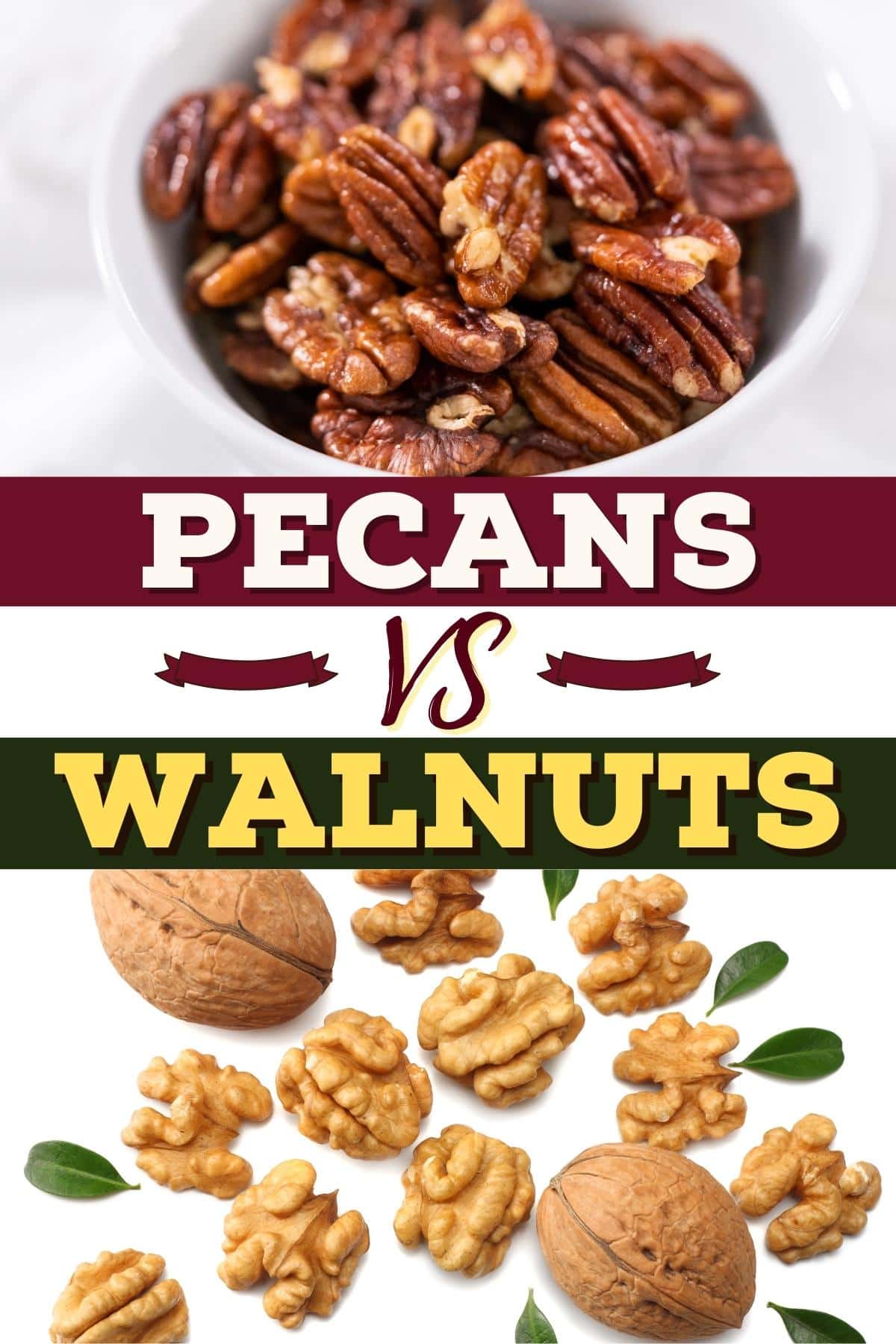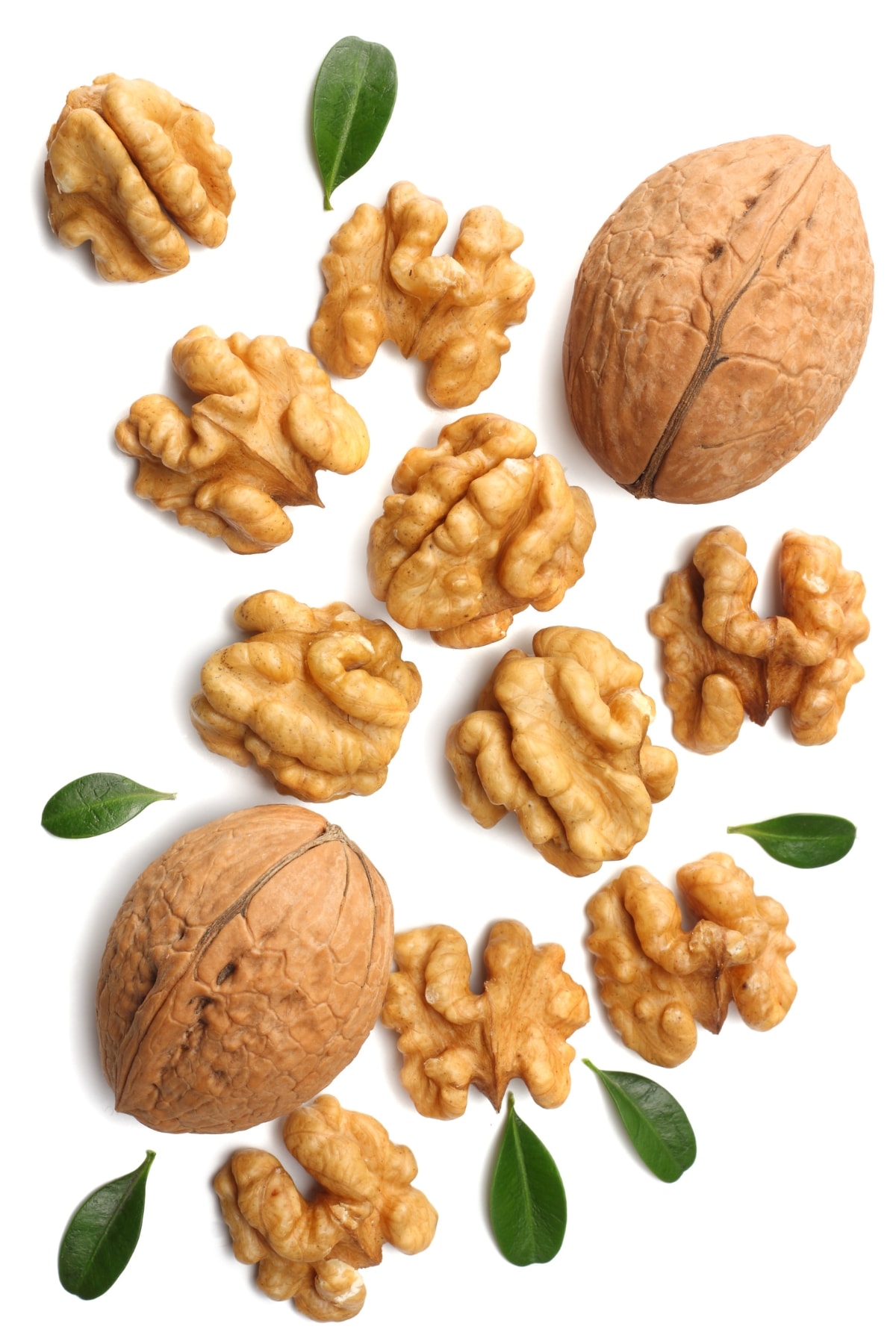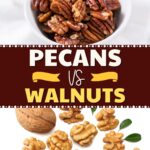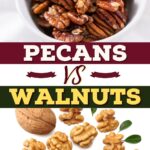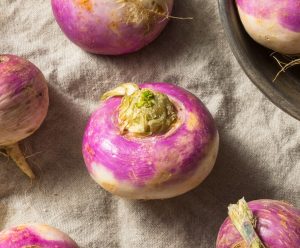Pecans and walnuts are both popular tree nuts, but they have distinct differences.
Pecans are sweeter and have a slightly buttery flavor with a thin, smooth shell. Walnuts are milder, with a slightly bitter note. They also have a crinkled, thicker shell that needs cracking.

Sure, their taste and texture profiles are similar. But nutritionally, pecans are higher in fat and calories, while walnuts are known for their omega-3 fatty acids.
Join me as I dive deeper into their differences. Plus, get tips on how best to use pecans and walnuts.
Pecans vs. Walnuts (What’s the Difference?)
Pecans and walnuts certainly share similarities. Apart from their nuttiness and crunch, they have one more thing in common. Though they’re categorized as “nuts,” their biological designation is a little more nuanced.
They both fit the characteristics of a true nut, but they also fit in with a fruit family called drupes. Since they meet the criteria for both, pecans and walnuts are sometimes called “drupaceous nuts.”
But enough about their similarities. Now it’s time to take a closer look at their differences.
Appearance
Both are often compared to a brain in shape, but let’s dive deeper.
Pecans have a hard, sleek shell. It’s reddish-brown and slightly elongated with pointy ends. The shell might also sport darker brown streaks or spots here and there.
Crack that shell open, and you’ll find a kernel resembling a brain to some extent. It has a uniform shape and dark brown color. A noticeable ridge runs down the middle.
Walnuts differ significantly. Their shell is a little lighter in color, tougher, more rounded, and quite bumpy compared to the pecan’s. The kernel is tucked away under brown skin, which is rich in antioxidants.
The inside of the walnut also has a brain-like appearance, complete with crevices and bumps. But the flesh is more brittle. It breaks apart when the shell is cracked open.
Taste
Now, onto the tastiest topic: the flavor profiles of pecans and walnuts.
Pecans are slightly sweet and chewier than walnuts. They’re nutty and buttery, thanks to their high oil content. It also gives them a delightful, crisp, and somewhat chewy texture.
Because of their natural sweetness, pecans are a great snack and a common addition to many desserts. And for those who don’t eat meat, pecans are also a handy substitute.
Walnuts have a deeper, nuttier flavor with a touch of bitterness, especially in the papery skin. The meat of the walnut is tangy, sweet, and earthy. Its creamy texture makes it a beloved ingredient in many recipes.
You mostly find English walnuts in the U.S. But black walnuts are another variety you come across. Black walnuts are darker with a thinner shell and offer a bolder flavor than English walnuts.
Culinary Uses
Pecans and walnuts are versatile and can be used in various dishes, from savory meals to sweet treats.
With their sweet, rich flavor and crunchy texture, pecans are popular for baking. You find them in chocolatey fudge brownies or as a topping on a festive cake. Pecans can even be ground up to make a tasty pie crust.
The key to getting the most out of pecans is to toast them. This can be done in a pan on medium heat until they smell nutty. Or, pop them in the oven at 325 F for about 7-10 minutes. Toasting gives them an even crunchier texture and a deepened flavor.
Walnuts and their mild yet sweet taste are great in stuffing or paired with cheeses on a board. The bitterness of walnuts beautifully balances the richness of these ingredients.
Just like pecans, walnuts are a favorite in baked goods. Whether it’s a moist walnut babka or chewy chocolate chip cookies, they add a buttery sweetness.
And yes, roasting/toasting is a game changer for walnuts, too. Roast your walnuts on the stovetop for 5-7 minutes and let them cool. Rub off most of the skin with a kitchen towel. Or, toast them in the oven at 325 F for about 7-10 minutes, and you’re good to go.
Price and Availability
Nuts are tasty and healthy, but they’re pricey. This is because nut trees need lots of resources to grow. Plus, their yield isn’t as large as other crops.
Pecans are usually less expensive than walnuts, but prices can change. Factors like the weather, which affects the crop yield, and demand can influence prices.
But don’t worry, finding these nuts isn’t a challenge. Both pecans and walnuts are widely available in the U.S.
You can find them at your local market or grocery store. You can also buy them online from various sellers. Some websites even lead you straight to the nut farmers.
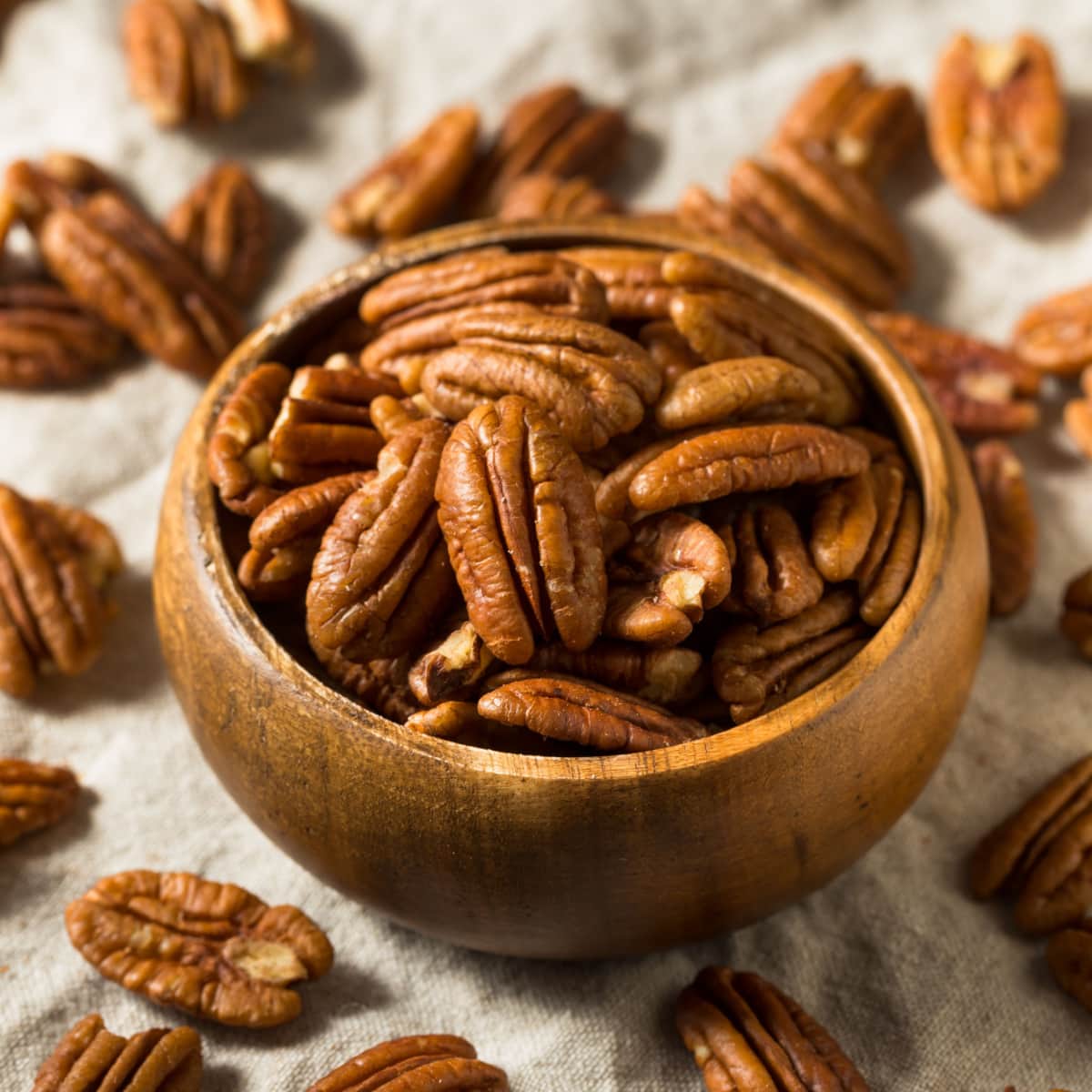
What Are Pecans?
Pecans are nuts that come from a type of hickory tree. The tree belongs to the Juglandaceae family, just like the walnut tree.
Most of the world’s pecans are grown in the United States and Mexico. These two countries produce over 90% of all the pecans in the world!
Native Americans were the first to discover these nuts. They loved to eat them and also used them for trading.
When Europeans came to America in the 16th century, they named pecans “nuez de la arruga,” which means “wrinkle nut.”
Just like walnuts, pecans are drupes. A drupe is a fruit with a seed surrounded by a hard shell. A green husk covers the shell.
Types of Pecans
More than 500 pecan varieties exist. However, only a few, like Stuart, Desirable, Moreland, Cape Fear, and Natives, are common in the United States.
Every type of pecan is a little bit different. Some have thicker shells and smaller nuts, while others have thin shells and big nuts.
The taste can vary, too. Some pecans are bitter, while others are not.
Even the shape is different. Some pecans look like a football, and others are round.
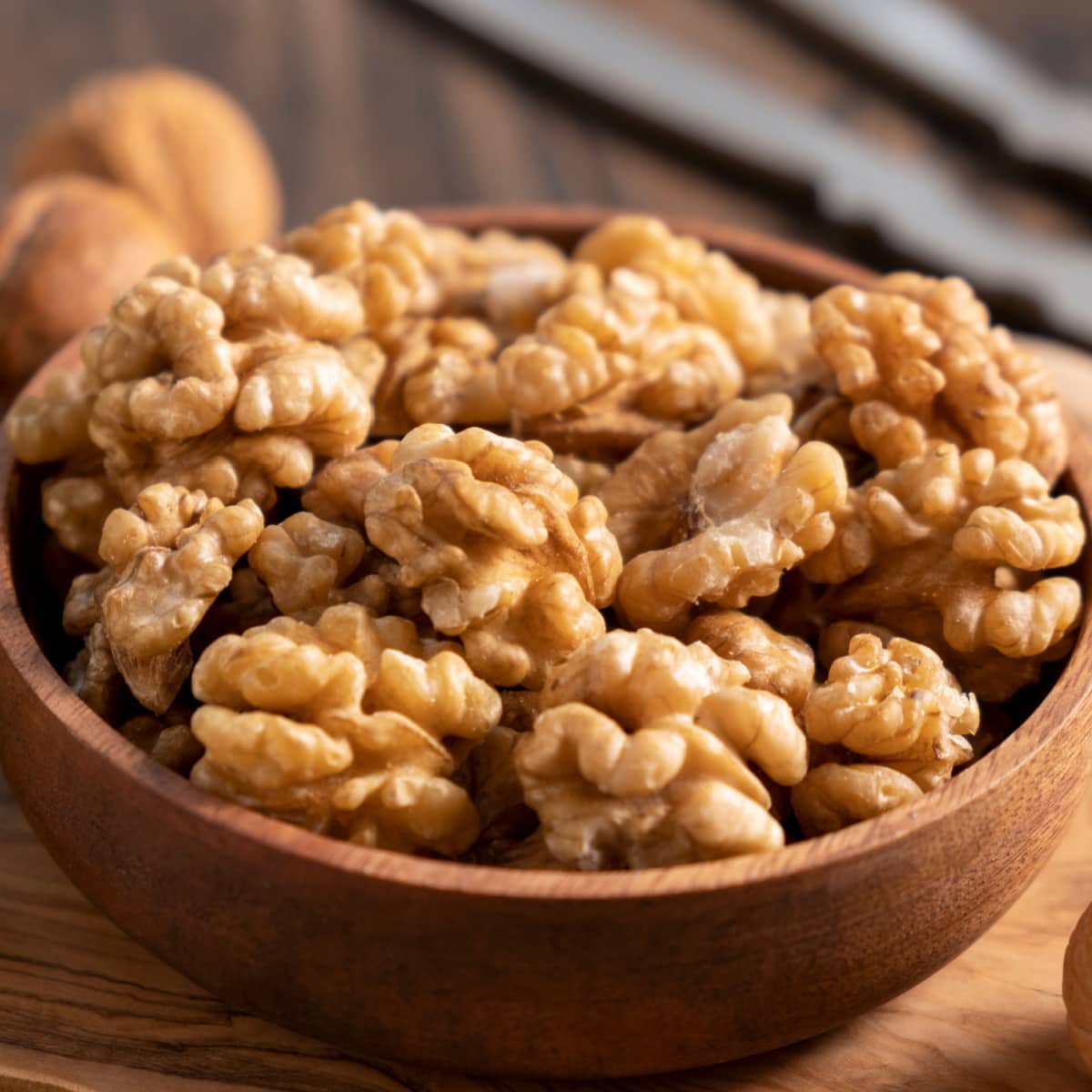
What Are Walnuts?
Walnuts are edible seeds from the trees of the Juglandaceae family. Walnuts are also considered nuts because they have a single seed, a tough shell, and a protective husk.
When the walnut ripens, the husk is removed, leaving behind a hard, wrinkled shell.
Inside the shell, there’s the walnut meat. When the shell is cracked open, you see two walnut segments.
Types of Walnuts
There are over 50 species of walnuts, but only two are commonly sold.
The first is the English walnut, also known as the California or Mission walnut. It’s actually from Asia and the Balkans, but now it’s grown in Europe, Asia, and the western U.S. It has a thin shell that’s easy to crack and has a gentle taste.
The second type is the black walnut, also known as the California black walnut. It’s native to the U.S. and grows wild in the central and eastern parts of the country. It has a thick shell that’s tough to crack. It also has a strong flavor.
Can You Substitute Pecans for Walnuts and Vice Versa?
You bet! Pecans and walnuts can play swap in recipes. While they have a different texture and taste, they’re close.
They both do great in sweet recipes. But walnuts are a better fit if you’re cooking something savory.

Pecans vs. Walnuts (Which Is Better?)
It depends on what matters to you. If you’re watching your budget, go for pecans. They cost less. They won’t last as long as walnuts do, though. If size matters in your recipe, pick walnuts.
Thinking of your heart? Choose walnuts. They’re packed with omega-3s. They’re also higher in protein. And if you want to keep blood sugar down, pecans are your friend. They’re low-carb and high-fiber.
Baking a sweet treat? Either pecans or walnuts will do. If your dish is savory, though, walnuts work better.
For me, why choose? Stock both in your kitchen!
